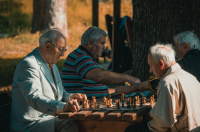There’s no need to head out to an archive and browse through dusty documents to discover the history of your lineage. These simple activities, well-suited for a family gathering, can be a great place to start.
Draw your family tree together
Your family tree is the backbone of your research, so we suggest starting with that. It’s a great tool to visualize family ties. One way to go is to only include your direct ancestors (you, your siblings, your parents, their parents, etc.) and the other one – to add all known relatives.
If several family members are present, you can even hold a contest and see who can list the biggest number of people they’re related to. Alternatively, let the youngest person start making the tree and then the older generations can help build it up.
For those who struggle with drawing from scratch, there are cute family tree prints on sale that can be filled out, framed, and put on a wall.
Browse through old pictures…
Some people are lucky enough to own a collection of really old photos, but it’s not always the case that they can actually name the people in them. Therefore, it’s great to look through the photo albums, examine the captions, ask your older family members if they know who’s in the pic, write down all the info you’ve got, and make sure those valuable objects are stored properly for future generations.
… and take new ones
This may sound absurd in an age where we all take endless pictures using our smartphones, but how many of them are actually good enough to be printed out and saved for the years to come? Consider taking a family portrait with a bit more preparation than usual – booking a photographer is one option, but simply paying some attention to details (lighting, background, etc.) will also do the trick.
Explore family geography
People tend to move around, which means that if you think about it, you’ll probably be able to come up with more than a few locations that are significant to your family. Visualizing them on a map can be a fun way to bring back memories related to specific places – or, perhaps, it will lead you to plan a trip to a place your ancestors came from.
You can either put pins on a store-bought map or print out a blank region/country outline and personalize it – draw lines to see who moved to one place or another and come up with your own map legend.
If you feel like digging deeper, you will need to continue your research by studying documents, such as the ones we talked about in this story.




